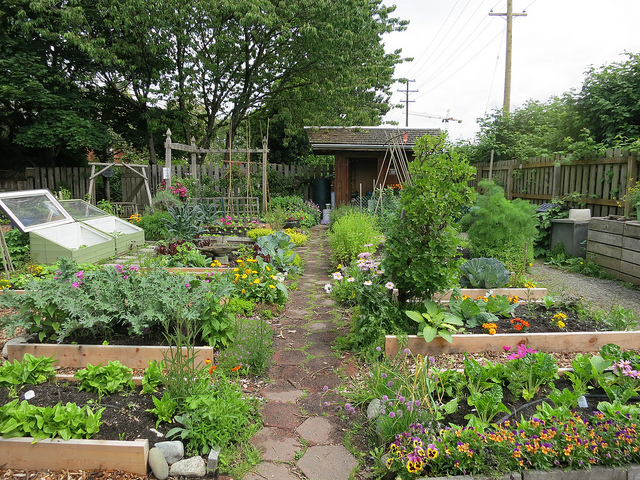The ever-important vegetable garden layout is on the minds of many gardeners now that spring is officially here. There are many things to consider when planning your vegetable garden.
Follow our tips to enjoy a beautiful and productive garden this year.

Photo via Creative Commons/Ruth Hartnup
Location
The location of your vegetable garden is the most vital decision you’ll make. The perfect spot will not only grow the best vegetables, but make maintenance much easier for you, the gardener.
Vegetable gardens should be placed in a space that gets full sun, 6-8 hours at a minimum. The soil should be fertile and drain well. It’s a good idea to get the soil tested by your local cooperative extension and amend it as needed before planting.
Be sure to visually lay out the garden before doing any digging or planting. Situating the vegetable garden close to the house will make it easier to care for. At the very least, make sure it’s within reasonable distance from the hose for ease of watering.
Size
When laying out the garden, it’s essential to be able to access the crops with ease. To be sure you can reach into the center of the garden for weeding and harvesting, measure the width to no wider than 4 feet.

Photo via Creative Commons/Woodley Wonder Works
Positioning your plants for optimal growth
Finding the right placing for each crop in the garden can be a challenge. It helps to observe sun patterns and plan accordingly. Plants that grow to enormous sizes should be placed so that they won’t overshadow shorter crops. Another good consideration for your vegetable garden layout is to plant crops with their companions.
Northern
Monstrous plants should be positioned on the north side of the garden so as not to cast shadows on the rest of the garden. Vegetables and grains such as corn, wheat, beans and peas fall into this category. If you’re planning to train climbers up trellises, such as squash and melons, these can be situated on the northern end as well, otherwise they can go in the center
Central
Large sprawling crops should be situated in the center of the garden. Broccoli, cabbage, and of course, the squash and melons mentioned previously, as long as they aren’t trained to climb.
Southern
Smaller, short crops can go on the south side of the garden. Lettuce, carrots, radishes and onions fall into this category.
Companion planting
Consider planting your crops with their companions for great plant health. Planting beans, squash and corn together in a three sisters garden will benefit all three plants. Planting lettuce underneath a cucumber trellis or towering tomato plant can help keep the delicate leaves from getting sun scorched.
Another options is staggering planting. Planting early crops with late crops is like getting a 2-for-1 deal! For instance, short season crops like radishes can be planted in the same spot as long season crops like squash. The radishes will grow to harvest in just a month and can be pulled before their roots are disruptive to the squash. This is a great way to grow a large amount of food in a small space.
Containers
A special note needs to be made for invasive crops. There are several crops that should be grown separately in containers to keep them from overtaking your garden. Horseradish, mint and strawberries are good examples of invasive plants. They spread quickly, like weeds, and are hard to contain once they get started.
These plants can grow well in a container, be placed in their own separate garden, or grow in bottomless pots sunk into the ground.
Now that you know how you’re going to layout your garden this year, head on over to our post on early spring gardening tips for an in-depth view on gardening systems and plant varieties.
Online Gardening Class
Gain design skills and make your garden the envy of your neighbors. Enroll Now »
Share tips, start a discussion or ask other students a question. If you have a question for an expert, please click here.
Already a member? Sign in
No Responses to “Planning the Perfect Vegetable Garden Layout”